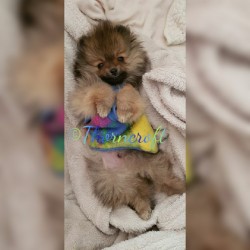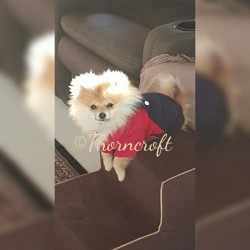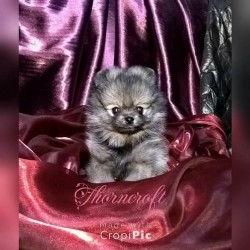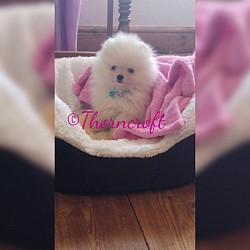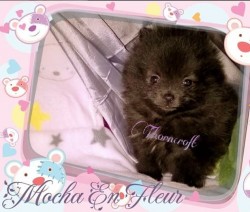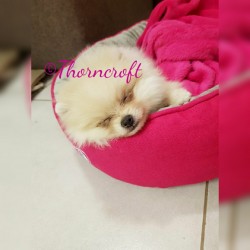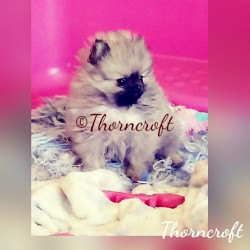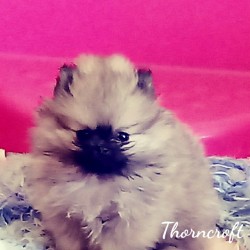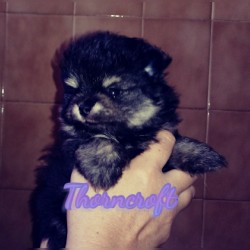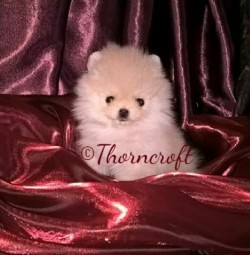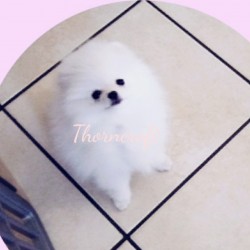Pomeranian Colours Explained
Pictures of Thorncroft Bred Pomeranians:
The Pomeranian breed comes in a wide variety of colours.
Orange; Orange Sable; Cream; Cream Sable; Wolf Sable ( a very rare colour; alot claim to have this colour but usually it is a normal cream sable that is passed off as a "wolf sable", so beware not to pay a large amount [because this colour is hard to breed and not alot of breeders produce this colour. Please refer to the section describing the colour to understand the colour before buying a puppy or adult that is claimed to be a Wolf Sable. Usually breeders keep them or will look for a show home for this colour, they are almost never sent to a companion home, unless a contract and agreement on co-ownership is agreed on, where the breeder will use the dog for breeding and show purposes. White colour; Champagne colour; Parti colours; Black and Tan ( I love this colour which is also a rare colour - a well bred Black and Tan colour Pomeranian is absolutely gorgeous with their markings (that have to be correct), emphasizing their features through their correctly placed markings. Chocolate colour; Chocolate and Tan colour; Black colour.
Colour Description of Pomeranians:
Sables:
A Sable Pomeranian will have a solid base coat and the sable comes into play via guard hairs that have black tips.
- Orange: - Can range from light Orange to dark orange. Eye rims, paw pads, nose, lips must be black - good pigment.
- Cream: - It can be very light to almost a colour that one might consider to be a lemon shading. Pigment must be good, black eye rims, lips, nose, paw pads.
- Black: - Deep very dark black coat. Good pigment, black lips, eye rims, nose, paw pads.
- Blue: - The easiest to determine this colour is to look at the nose, paw pads, eye rims and lips - it should have a blue. A true Blue also has blue pigmentation - skin colour is blue.
- White - A true white is Ice White - Snow White. With NO shading to the coat - because then the colour would be a cream. Good pigment, meaning; black eye rims, nose, lips and paw pads.
- Wolf Sable - Light grey undercoat with a darker shade of steel grey guard hairs with black tips. NO orange or cream tint to the grey base colour. Good pigment, meaning - black eye rims, black lips, black nose and paw pads.
- Chocolate: - Think of the colour - Mocha. Here you also identify a true chocolate at looking at the nose, lips, eye rims, paw pads - they should be brown ( chocolate colour).
Parti Coloured Pomeranians come in three types:
A): - Irish Parti Colour: Must have a white collar, chest, legs, and blaze. Again as mentioned above must have good pigmentation.
B): - Piebald Parti Colour: This Pomeranian will have 50/50 colouring. Must have good pigmentation.
C): Extreme Piebald Parti: - This Pomeranian will have 80% and can be even more of white coat colour, and will have spots of other colour on his/her back.
Important note when assessing a Parti Coloured Pomeranian is: This Pomeranian has a white base coat with other colour/s present.
- Tan Points: - Pomeranians with tan points come in three colours - black; brown; and blue. All three base colours share the same tan marking pattern.
- Pattern: - The pattern is sharply defined with Tan points appearing above each eye, on both sides of the muzzle, cheeks, inside of ears, throat, fore chest - which has either one very large tan spot or two tan spots called "rosettes" on each side of the chest above the front legs. On all legs and feet, there may be a distinct "pencil mark" line in the base colour running lengthwise on the top of each toe on all four feet. The underside of the tail, which is on top when the tail is carried over the back; and the pantaloons, or skirt. The tan colour ranges from a light cream ( sometimes referred to as "silver"), to a dark mahogany rust.

